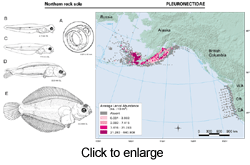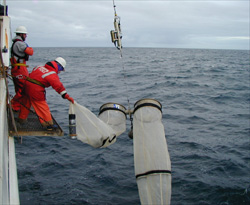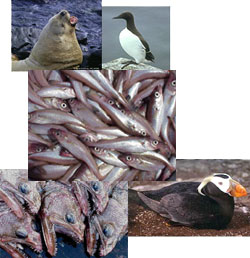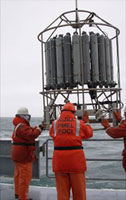

Recruitment Processes Program
 The Recruitment Processes Program's overall goal is to understand the mechanisms that determine whether or not marine organisms survive to the age of “recruitment.” Recruitment for commercially fished species occurs when they grow to the size captured or retained by the nets or gear used in the fishery. For each species or ecosystem component that we study, we attempt to learn what biotic and abiotic factors cause or contribute to the observed population fluctuations. These population fluctuations occur on many different time scales (for example, between years, between decades). The mechanistic understanding that results from our research is applied by us and by others at the Alaska Fisheries Science Center to better manage and conserve the living marine resources for which NOAA is the steward. The Recruitment Processes Program's overall goal is to understand the mechanisms that determine whether or not marine organisms survive to the age of “recruitment.” Recruitment for commercially fished species occurs when they grow to the size captured or retained by the nets or gear used in the fishery. For each species or ecosystem component that we study, we attempt to learn what biotic and abiotic factors cause or contribute to the observed population fluctuations. These population fluctuations occur on many different time scales (for example, between years, between decades). The mechanistic understanding that results from our research is applied by us and by others at the Alaska Fisheries Science Center to better manage and conserve the living marine resources for which NOAA is the steward.
 Our group began in the late 1970's as a team of scientists principally concerned with the early life history (eggs, larvae and early juveniles) of fish species from the North Pacific Ocean. Studies were conducted off the U.S. west coast, the Gulf of Alaska, and eastern Bering Sea off Alaska. Over the years, the Program has collected tens of thousands of ichthyoplankton (larval fish) samples. These provide an unparalleled resource for study of the distribution and abundance of a wide variety of fishes, and how they relate to the ocean environment. The program has developed many new analytical methods, field observation tools, and state-of-the-art simulation models necessary to carry out these studies. Our group began in the late 1970's as a team of scientists principally concerned with the early life history (eggs, larvae and early juveniles) of fish species from the North Pacific Ocean. Studies were conducted off the U.S. west coast, the Gulf of Alaska, and eastern Bering Sea off Alaska. Over the years, the Program has collected tens of thousands of ichthyoplankton (larval fish) samples. These provide an unparalleled resource for study of the distribution and abundance of a wide variety of fishes, and how they relate to the ocean environment. The program has developed many new analytical methods, field observation tools, and state-of-the-art simulation models necessary to carry out these studies.
 Today the program is still known for its expertise in early life history studies, but we have diversified our research interests as NOAA has shifted its focus from management of single species to stewardship of entire ecosystems. Our projects now include recruitment processes of other living marine resources (e.g. commercially valuable shellfish, marine mammals, and seabirds), as well as the study of processes that affect multiple trophic levels within an ecosystem. Today the program is still known for its expertise in early life history studies, but we have diversified our research interests as NOAA has shifted its focus from management of single species to stewardship of entire ecosystems. Our projects now include recruitment processes of other living marine resources (e.g. commercially valuable shellfish, marine mammals, and seabirds), as well as the study of processes that affect multiple trophic levels within an ecosystem.
The program is organized into projects (and sub-Projects) each with a different focus or expertise. There is extensive cooperation and collaboration among Projects within the Recruitment Processes Program as well as with other research Programs at the Alaska Fisheries Science Center, and with scientists from around the world. Our projects are:
A significant aspect of the Recruitment Processes Program is our participation in the Ecosystems &s Fisheries-Oceanography Coordinated Investigations (EcoFOCI) program,  which is a cooperative research effort with the Pacific Marine Environmental Laboratory (PMEL) and the Office of Oceanic and Atmospheric Research (OAR). EcoFOCI evolved from our original project FOCI that was initiated to identify and understand the causes of annual recruitment variations in fish stocks of economic importance in the Gulf of Alaska and Bering Sea ecosystems. The research is funded by NOAA and is directed at understanding the causes of large natural fluctuations of walleye pollock stocks that spawn in Shelikof Strait (Gulf of Alaska) and in the eastern Bering Sea. The research was originally based on the paradigm that recruitment of pollock to mature populations is largely set during the egg and larval stages, where a suite of physical and biological processes influence the survival of larval pollock to the juvenile stage. The current paradigm includes the importance of mortality during the juvenile stage. The knowledge gained by FOCI is applied in stock assessment models to forecast future recruitment levels. Precise and accurate recruitment forecasts will increase the accuracy of predicting future stock abundance, which in turn helps the North Pacific Fishery Management Council manage the fishery. The program is currently making annual forecasts of future recruitment levels for pollock in the Gulf of Alaska. which is a cooperative research effort with the Pacific Marine Environmental Laboratory (PMEL) and the Office of Oceanic and Atmospheric Research (OAR). EcoFOCI evolved from our original project FOCI that was initiated to identify and understand the causes of annual recruitment variations in fish stocks of economic importance in the Gulf of Alaska and Bering Sea ecosystems. The research is funded by NOAA and is directed at understanding the causes of large natural fluctuations of walleye pollock stocks that spawn in Shelikof Strait (Gulf of Alaska) and in the eastern Bering Sea. The research was originally based on the paradigm that recruitment of pollock to mature populations is largely set during the egg and larval stages, where a suite of physical and biological processes influence the survival of larval pollock to the juvenile stage. The current paradigm includes the importance of mortality during the juvenile stage. The knowledge gained by FOCI is applied in stock assessment models to forecast future recruitment levels. Precise and accurate recruitment forecasts will increase the accuracy of predicting future stock abundance, which in turn helps the North Pacific Fishery Management Council manage the fishery. The program is currently making annual forecasts of future recruitment levels for pollock in the Gulf of Alaska.
 Our other major program, North Pacific Climate Regimes and Ecosystem Productivity (NPCREP) focuses on the interactions between climate and ecosystems. This Program, begun in 2002 and funded by NOAA’s Climate Goal Team, has spent most of its early life studying the rapid response of the eastern Bering Sea to warming and loss of sea ice. The goal is to increase our understanding of the important mechanisms that control the structure and function of marine ecosystems and to use that knowledge to predict future states of the ocean. Important tools for this program are observations and model that couple climate and biology. Our other major program, North Pacific Climate Regimes and Ecosystem Productivity (NPCREP) focuses on the interactions between climate and ecosystems. This Program, begun in 2002 and funded by NOAA’s Climate Goal Team, has spent most of its early life studying the rapid response of the eastern Bering Sea to warming and loss of sea ice. The goal is to increase our understanding of the important mechanisms that control the structure and function of marine ecosystems and to use that knowledge to predict future states of the ocean. Important tools for this program are observations and model that couple climate and biology.
Recruitment Processes and EcoFOCI also receive extramural funding to conduct studies on different aspects of the Large Marine Ecosystems (LMEs) in Alaska. These projects capitalize on the expertise of the group in lower trophic level and fish early life history research. Projects have been supported by the North Pacific Research Board, NOAA’s Coastal Ocean Program, and the National Science Foundation. These are often collaborations among NOAA and university scientists.
 One strength of Recruitment Processes and EcoFOCI as Programs is the ability to call upon the talent of many different scientists to work collaboratively on difficult problems. These projects often have strong field observational components and use data from our annual series of research cruises conducted aboard the NOAA ship Miller Freeman and FRV Oscar Dyson, During these cruises we census zooplankton, fish eggs and larvae, measure ocean and weather variables, investigate transport of fish larvae and the densities of their predators and prey. The results are used in several different ways. The first way is to use the observations and statistics to test our hypotheses of how the ecosystem works. The second way is to use the observations in computer simulations that model ocean processes and biological elements. As these projects progress, the modelers develop first-order models to forecast future recruitment or population levels. These results are often used in stock assessment models for generating annual management advice of future harvest levels. Research findings from the first two uses of our field data are documented in scientific publications. The last way to use the data is to make metrics or indices for the state of the ecosystem and to track these over time. Our observations are used and tracked by both the Bering Climate Page and the Ecosystems Considerations Chapter presented to the North Pacific Fishery Management Council. One strength of Recruitment Processes and EcoFOCI as Programs is the ability to call upon the talent of many different scientists to work collaboratively on difficult problems. These projects often have strong field observational components and use data from our annual series of research cruises conducted aboard the NOAA ship Miller Freeman and FRV Oscar Dyson, During these cruises we census zooplankton, fish eggs and larvae, measure ocean and weather variables, investigate transport of fish larvae and the densities of their predators and prey. The results are used in several different ways. The first way is to use the observations and statistics to test our hypotheses of how the ecosystem works. The second way is to use the observations in computer simulations that model ocean processes and biological elements. As these projects progress, the modelers develop first-order models to forecast future recruitment or population levels. These results are often used in stock assessment models for generating annual management advice of future harvest levels. Research findings from the first two uses of our field data are documented in scientific publications. The last way to use the data is to make metrics or indices for the state of the ecosystem and to track these over time. Our observations are used and tracked by both the Bering Climate Page and the Ecosystems Considerations Chapter presented to the North Pacific Fishery Management Council.
*Featured Item*
Ann Matarese, Janet Benson, Deborah Blood, Susan Picquelle, and William Rugen receive the NOAA Bronze Medal. More>
|
Recent Publications, Poster Presentations, Reports & Activities |
- NAPP, J.M., A.W. KENDALL, Jr. and J.D. SCHUMACHER. 2000. A synthesis of biological and physical processes affecting the feeding environment of larval walleye pollock (Theragra chalcogramma) in the eastern Bering Sea. Fisheries Oceanography, Vol. 9, Issue 2, pp. 147-162 (June 2000)
- KENDALL, A.W., Jr., J.D. SCHUMACHER and S. KIM (1996). Walleye pollock recruitment in Shelikof Strait: applied fisheries oceanography. Fisheries Oceanography, Vol. 5 (Supplement 1), pp. 4-18.
- DOYLE, M. J., S. J. PICQUELLE, K. L. MIER, M. C. SPILLANE, and N. A. BOND.
2009. Larval fish abundance and physical forcing in the Gulf of Alaska, 1981-2003. Prog. Oceanogr. 80:163-187.
- HOLLIDAY, D. V., P. L. DONAGHAY, C. F. GREENLAW, J. M. NAPP, and J. M. SULLIVAN.
2009. High-frequency acoustics and bio-optics in ecosystems research. – ICES J. Mar. Sci. 66:974-980.
- HINCKLEY, S., J. M. NAPP, A. J. HERMANN, and C. PARADA.
2009. Simulation of physically mediated variability in prey resources of a larval fish: a three-dimensional NPZ model. Fish. Oceanogr. 18:201-223.
- CARTWRIGHT, R. L.
2009. Description of early life history stages of the northern sculpin (Icelinus borealis Gilbert) (Teleostei: Cottidae). Fish. Bull., U.S. 107:175-185. (.pdf, 1.04 MB). Online.
- HOLLOWED, A. B., and K. M. BAILEY.
2009. Climate and fisheries: the past, the future, and the need for coalescence, p. 597-619. In R. J. Beamish and B. J. Rothscild (editors), The Future of Fisheries Science in North America, Vol. 31, Fish & Fisheries Series, Springer. Secaucus, NJ.
- HOLLOWED, A. B., R. BEAMISH, T. OKEY, and M. SCHIRRIPA.
2008. Forecasting climate impacts on future production of commercially exploited fish and shellfish. PICES Sci. Rep. No. 34. 101 p.
- Early Larvae of Zesticelus profundorum (Family Cottidae) Identified Using DNA Barcoding
By: ANN C. MATARESE, INGRID B. SPIES, MORGAN S. BUSBY, JAMES W. ORR
Conference: Larval Fish 33rd Annual Conference, Portland, OR, July 2009
(2009 poster, .pdf, 1.57MB) Online.
- Early Life History of Greenland Halibut (Reinhardtius hippoglossoides) in the Eastern Bering Sea Based on Recent Field Studies (2007-2009): Spawning,
By: DEBORAH M. BLOOD, JANET T. DUFFY-ANDERSON, ANN C. MATARESE, DONGWHA SOHN, PHYLLIS J. STABENO, WEI CHENG
Conference: Larval Fish 33rd Annual Conference, Portland, OR, July 2009
(2009 poster, .pdf, 936KB) Online.
- Near Real-time Forecasting of Recruitment from Larval Surveys: Application to Walleye Pollock in the Western Gulf of Alaska
By: KEVIN M. BAILEY, STEVEN M. PORTER, SUSAN J. PICQUELLE, ANNETTE B. DOUGHERTY, TIANYANG ZHANG, KUNG-SIK CHAN
Conference: Larval Fish 33rd Annual Conference, Portland, OR, July 2009
(2009 poster, .pdf, 1.77MB) Online.
See the publications and poster databases for additional listings.
|
To view and print these documents, you must install
Adobe Reader freeware. Adobe also offers
free tools for the visually disabled.
|